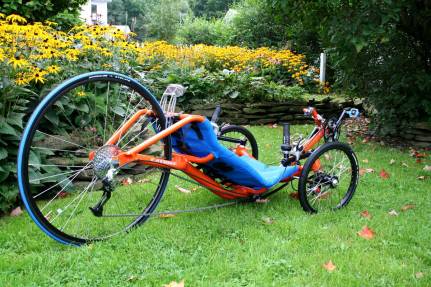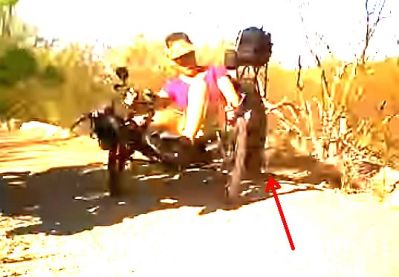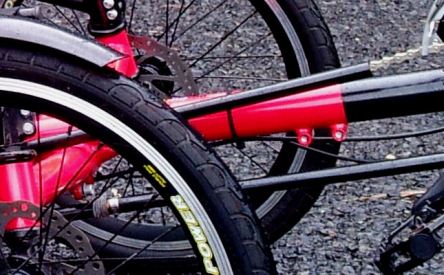Low & Slow … no, I am not talking about whiskey or any other alcoholic drinks nor am I am talking about Bar-B-Que (there is a restaurant where I live called Low & Slow.) Nope, I am talking about tadpole trikes … they are low & slow. At least this is true for many of us who ride tadpole trikes. That’s okay on both accounts in my book. The good thing about a tadpole trike is not that they have to go slow, but that they can go slow. And being low has its advantages.
Riding a tadpole trike is somewhat like riding a go-cart although a go-cart most definitely handles even better. And there is certainly nothing slow about most go-carts. Some really fly. I remember as a teenager riding a motorcycle. I was always impressed at how fast many motorcycles could accelerate compared to most cars. A friend of mine had a younger brother who had a go-cart. In talking it was decided that we would have a race. I assumed I could out accelerate him, but when we took off he shot out ahead of me like I was sitting still. I was quite impressed as well as embarrassed. Now that has absolutely nothing to do with what I set out to talk about here. It is just a story that came to mind I thought I would share.
Seriously, many have compared riding a tadpole trike to riding a go-cart or driving a sports car. I agree to an extent, but in all honesty both will readily out handle a tadpole trike. However, tadpole trikes are a blast to ride. I used to ride a recumbent bike. I could go faster on it than I can on my tadpole trike, but I found the trike so much more fun to ride as well as more comfortable. So I found myself riding the trike and the bike just sat around. I finally sold the bike and don’t miss it at all. The truth is my wife has a bike identical to the one I had and I can ride it anytime I want. I don’t ride it though as I have my tadpole trike to ride. I may take her bike out sometime later this year just so I can go a bit faster. 🙂 I am sure I won’t make a habit of it though. 😉

My grandniece sitting on my trike … about 9 inches off the pavement
As to the matter of being low tadpole trikes all started out being made to sit pretty low. However, in more recent years some models have been appearing with some pretty high seats which, of course, means that they are not so low. That is not for me. As long as I can get in and out of a lower seat that will be what I prefer to ride. I have tried riding a trike with a very high seat and didn’t care for it at all. The handling and feel of it suffers greatly. No, I want the seat down as low as it can go and still have sufficient ground clearance so the frame clears stuff under it. Sitting just 9 inches off of the ground is my cup of tea.

As to the speed, that is one of those things which varies by the individual rider. Like anything else the “motor” determines what the capability is. Definitely downhill on a tadpole trike is a thrill and they can blast past 2 wheeled bicycles of all sorts. Some trikes are faster than others. That is they are designed to be faster. Again, it is all dependent upon the “motor”. I am sure there are those who can ride a Catrike Villager faster than some could ride a Catrike 700 (using Catrike as an example).
Speaking of the Catrike 700, it as well as the ICE VTX and CarbonTrike models all have a 25 degree seat angle. One’s buttocks are the same height, but the torso and head is positioned lower so in that sense the rider is lower. Of course, not every cares to lean back that far and, indeed, not everybody can handle it physically.
The one thing I really love about riding a tadpole trike is having the ability to go really slow … even stopping on an incline and starting back climbing it again when you are ready to do so. And there is no concern about balancing, falling over or having to put your feet down. You sure can’t do that on a bicycle.
Sitting just inches off of the ground one doesn’t have very far to fall should something go afoul. And being down low makes it appear as though you are going faster than you actually are. That adds to the fun of riding a tadpole trike.
A tadpole trike is capable of carrying heavy loads and being pedaled at slow speeds … and in comfort. Try that on a bicycle.
Yep, low and slow … it’s okay by me. I plan on …
KEEPIN’ ON TRIKIN’
_____________________________________
A FREE GIFT awaits you!
tadpole trike, tadpole trikes, tadpole tricycles, recumbent trikes, recumbent tricycles, recumbent tadpole trikes, recumbent tadpole tricycles, American Cruiser, Atomic Zombie, Azub, Bikes Reclinadas, CarbonTrikes, Catrike, Challenge, David Bruce Trikes, Edge Recumbents, Evolve, FFR Trikes, Fortrike, Greenspeed, HP Velotecknik, ICE, KMX, Logo Trikes, Outrider USA, Performer, Podersa Cycles, Scarab, Steintrikes, SunSeeker, TerraTrike, Ti-Trikes, Trident, TrikeWars, TriSled, TW-Bents, Utah Trikes, Windcheetah

































